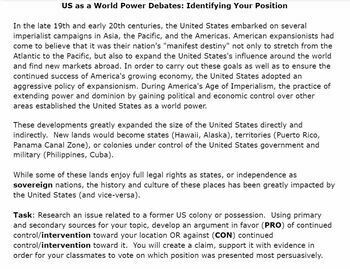Debates: US as a World Power: 1898 - Present
- Google Drive™ folder

Description
In the late 19th and early 20th centuries, the United States embarked on several imperialist campaigns in Asia, the Pacific, and the Americas. American expansionists had come to believe that it was their nation's "manifest destiny" not only to stretch from the Atlantic to the Pacific, but also to expand the United States' influence around the world and find new markets abroad. In order to carry out these goals as well as to ensure the continued success of America's growing economy, the United States adopted an aggressive policy of expansionism. During America's Age of Imperialism, the practice of extending power and dominion by gaining political and economic control over other areas established the United States as a world power.
These developments greatly expanded the size of the United States directly and indirectly. New lands would become states (Hawaii, Alaska), territories (Puerto Rico, Panama Canal Zone), or colonies under control of the United States government and military (Philippines, Cuba).
While some of these lands enjoy full legal rights as states, or independence as sovereign nations, the history and culture of these places has been greatly impacted by the United States (and vice-versa).
Task: Research an issue related to a former US colony or possession. Using primary and secondary sources for your topic, develop an argument in favor (PRO) of continued control/intervention toward your location OR against (CON) continued control/intervention toward it. You will create a claim, support it with evidence in order for your classmates to vote on which position was presented most persuasively.





